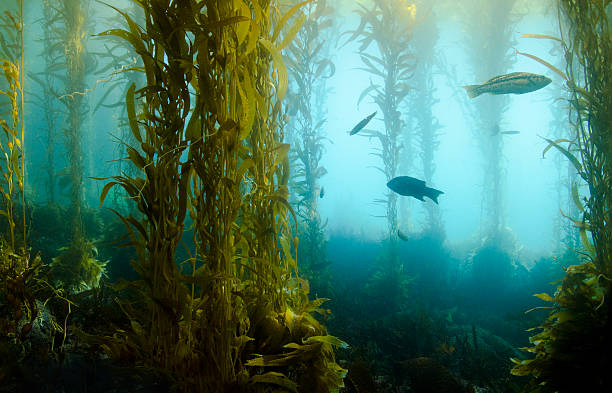Seaweed is more than just the key ingredient in every delicious cup of Offshore Greens™; it plays a vital role in the health of blue ecosystems and provides a wealth of ecosystem services. Ecosystem services are benefits that wildlife or ecosystems provide to people. You’ve likely seen mention of kelps ecosystem services on our site – from reducing ocean acidification to creating a refuge for sea creatures – but we wanted to unpack some details and highlight just how capable seaweed is.
Ecosystem Services: Part 1, Nutrient Bioremediation.
Seaweeds absorb nutrients to grow, including but not limited to nitrogen (N) and phosphorus (P). N and P are also nutrients that flood into our riverways and coastal waters, largely from agricultural and urban wastewater. An excess of these discharged nutrients can spell disaster; harmful algal blooms increase, oxygen levels decrease, and the fish and other marine animals that call those waters home die. The phenomenon is called Eutrophication, and it creates “dead zones” around the world.

Dead zones are concentrated around industrial coastal areas. In the Gulf of Mexico, eutrophication threatens the region’s $2 trillion contributions to the economy, partly by undermining Gulf fisheries which provide ~14% of US seafood. Source, HERE. Image: NASA Earth Observatory
Well, that was dark. Back to the light. Seaweed.
 “Seaweed aquaculture is one of the few tools that we know of to remove excess nutrients once they’ve entered coastal environments.” – Phoebe Racine, Researcher at UCSB Bren School of Environmental Science & Management
“Seaweed aquaculture is one of the few tools that we know of to remove excess nutrients once they’ve entered coastal environments.” – Phoebe Racine, Researcher at UCSB Bren School of Environmental Science & Management
Seaweed’s ability to lock away nutrients and clean polluted waters is gaining more attention every day – and for good reason. It’s a sustainable, lower-cost means of extracting N and P that produces an edible and incredible product in the process. Research on the matter shows promising results, as seen HERE at Stony Brook University, and compelling demonstrations exist in other parts of the world: Ie. China, where seaweed aquaculture annually removes ~75,000 tons of N and 9,500 tons of P.
Moreover, this win-win scenario – addressing marine nutrient pollution while producing a valuable crop – could help seaweed farms take shape and seaweed farmers make money. Seaweed experts such as Dr. Thierry Chopin at the University of New Brunswick point to the potential value of seaweed in nutrient trading credit schemes: “There is more money to be made with NTC (between US$ 1.1-3.4 billion for N and US$ 51.8 million for P) than with carbon trading credits (US$ 29.1 million).” Source, HERE.
Important note #1: When you eat seaweed that has absorbed N and P from polluting runoff, you are not consuming the polluting runoff; you’re just consuming N and P molecules. That’s it. Nothing gross.
 Important note #2: The overuse of fertilizers and other industrial processes that drive wastewater pollution must be mitigated. Seaweeds can help address eutrophication, but like emitting greenhouse gasses, the solution is to stop the pollution at the source!
Important note #2: The overuse of fertilizers and other industrial processes that drive wastewater pollution must be mitigated. Seaweeds can help address eutrophication, but like emitting greenhouse gasses, the solution is to stop the pollution at the source!
Nutrient Bioremediation is just one of many ecosystem services provided by seaweed. Stay tuned for upcoming posts highlighting Coastal Protection, Carbon Sequestration, Habitat Creation, and more.
References:
Racine et. al. “A case for seaweed aquaculture inclusion in U.S. nutrient pollution management.” Marine Policy. 2021.
Chopin, Thierry. Tacon, Albert “Importance of Seaweeds and Extractive Species in Global Aquaculture Production.” Reviews in Fisheries Science & Aquaculture, 2021

